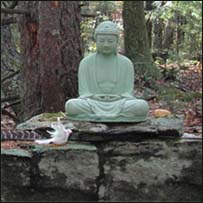|
|
 |
Please support Dharma Seed with a 2025 year-end gift.
Your donations allow us to offer these teachings online to all.

|

|

|
The greatest gift is the
gift of the teachings
|
|

|
| |
|
Dharma Talks
|
2025-06-22
How do I establish and know sati sampajañña?
28:04
|
|
Ajahn Sucitto
|
|
|
Ajahn responds to several questions around the themes: Is it necessary to have an attitude of sanctity or divinity when one is mindful in the sati sampajanna way? Is it possible to get anywhere in the practice without being ordained? How long should I sit and what particular process should I go through? Will I arrive at a certain recognizable state?
|
|
Dhamma Stream Online Sessions
|
|
|
2025-06-18
Q and A
57:31
|
|
Ajahn Sucitto
|
|
|
Q1 00:52 When you're walking around and brushing your teeth what's your experience of the sense world and nibbana? I'd like to experience more beauty and sacredness in the sense world and cultivate a relationship with the transcendent, but it feels so out of reach; Q2 17:43 Recently I listened to a talk by Ajahn Tanissaro and he said he didn't know any practitioner in the West who was a stream enterer. I was disheartened. Can you say something about this? Q3 28:09 can you give some advice on cell phones and technology please? They drain my energy quickly. Q4 35:34 (several questions) In mindfulness of breathing, does one proceed sequentially through the 16 phrases, or pick up the steps that seem to fit with whatever seems to be arising. Why is it presented as a graduated training? Also, can you speak about releasing the heart? Q5 44:18 What are the differences between attention and awareness? What are their Pali terms? Q6 49:42 "One reviews the extent to which one's mind is liberated..." In the Book of the 5s. If one's mind is non-liberated how do you go about it? Q7 52:59 How to relate when resistance arises in practice from feeling blocked, to discouraged or lost etc etc etc.
|
|
Insight Meditation Society - Forest Refuge
:
One Month Retreat at the Forest Refuge
|
|
|
2025-06-07
Q and A
43:32
|
|
Ajahn Sucitto
|
|
|
01 06 Q1 I don't have any particular devotional practice. Is this like a Brahmavihara practice? 01:41 Q2 Regarding the relationship between citta and yoni as in yoniso manasikara, I relate to citta on a moment to moment basis. Yoni seems to be a seat of integrated wisdom. 20:15 Q3 Can you explain about metta practice. 27:31 Q4 Someone said resentment and aversion are natural conditions of the mind. They're not self and when seen as not self, they disappear. Can you comment please? 34:17 Q5 I would like to know if the inner tyrant is considered wrong view.
|
|
Dhamma Stream Online Sessions
|
|
|
2025-06-07
A simple short refuge mantra is offered
3:20
|
|
Ajahn Sucitto
|
|
|
Buddhaṃ me jīvitaṃ yāva nibbānaṃ saranaṃ gacchāmi
Dhammaṃ me jīvitaṃ yāva nibbānaṃ saranaṃ gacchāmi
Sanghaṃ me jīvitaṃ yāva nibbānaṃ saranaṃ gacchāami
{To the Buddha I go for refuge living my life to realize nibbana
To the Dhamma I go for refuge living my life to realize nibbana
To the Sangha I go for refuge living my life to realize nibbana}
|
|
Dhamma Stream Online Sessions
|
|
|
2025-05-30
Embodied awareness and the 'me bag'.
60:30
|
|
Ajahn Sucitto
|
|
|
A talk given at the Insight Meditation Center of Western Mass with QnA.
Questions are précised: Q1 33:26 You were talking about the inner and outer skin. It seems this inner skin creates suffering. How do we start to be able to deal with this?Q2 37:34 Those words: Open, allow, let go are such a release. But something can happen that scares me, fear of annihilation. How do you practice with the insecurity of monastic life without being scared? Q3 42:03 In moving from control, do you go through indifference? Q4 43:50 Would you mind speaking about qualities of willfulness, striving, urgency, rigidity around meditation and holding attention in the body and that urgency. Q5 52:10 I feel very uplifted being so close to a monastic. Could you say something about the challenges and the fruits of being in robes for so long?
|
|
Insight Retreat Center
|
|
|
|
|